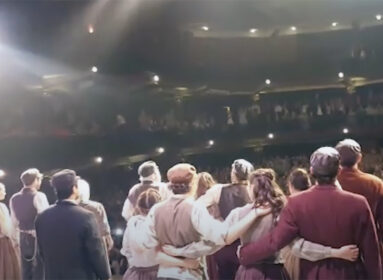By Cindy Mindell ~
On Mar. 18, 1922, a 12-year-old girl named Judith Kaplan read Torah during Shabbat services at the Society for the Advancement of Judaism in New York City. Kaplan didn’t actually read from a Torah scroll; instead, she read a passage in Hebrew and English, with the corresponding blessings, from a printed Chumash after the regular Torah service.

Judith Kaplan Eisenstein at the 70th anniversary of her bat mitzvah in 1992. Credit: Archives, Reconstructionist Rabbinical College.
Today, such an event would not cause much of a stir among most American Jews. In fact, many would ask why Kaplan wasn’t allowed to read from the scroll itself. Ninety years ago, at a time when girls and women were hardly allowed on the bimah, and were forbidden to even touch a Torah, Judith Kaplan’s bat mitzvah was something of a revolution. Judith was the oldest daughter of Rabbi Mordecai Kaplan, the founder of Reconstructionist Judaism, who believed that Jewish girls should have the same religious opportunities as their brothers.
By the 1960s, bat mitzvah was a regular feature of Conservative congregational life; today, it is a mainstay in synagogues from Reform to Modern Orthodox.
“The bat mitzvah is a quintessential American Jewish story,” says Ivy L. Barsky, director of the National Museum of American Jewish History (NMAJH) in Philadelphia. “Like so many of our stories, it is about negotiating in America between tradition and innovation, between acculturating and holding on to traditions as they once were. Our traditions and Judaism itself are living, breathing things and the bat mitzvah is a particularly poignant and moving example of that.”
This month, the museum marks the anniversary with special programming, and co-curates “Bat Mitzvah Comes of Age,” a traveling exhibition created by Moving Traditions.
Jewish law states that girls automatically reach religious maturation at 12 years and a day, and boys at 13 and a day. Public bar mitzvah ceremonies and rituals originated in the Middle Ages.

In the decades following the first bat mitzvah in 1922, some summer camps prepared to celebrate their b’not mitzvah. Pictured here is a bat mitzvah at Camp Cejwin in Port Jervis, N.Y., 1935. Ratner Center Archives, Jewish Theological Seminary
Most of the early American bat mitzvah ceremonies were held on Friday evening, when Torah is traditionally not read. Today, in egalitarian congregations, a bat mitzvah ceremony generally looks identical to a bar mitzvah, with girls chanting Torah on Saturday morning. More traditional congregations might observe any of a diversity of practices, such as a girl delivering a shiur, or lesson, or chanting Torah in the presence of women only.
“One of the motivating factors for the bat mitzvah, in the Conservative movement, was that the boys’ bar mitzvah ceremony was becoming too ostentatious for some, and losing some of its meaning,” Barsky says. “The idea was that, if the girls had a bat mitzvah, it would bring meaning and gravity back to the milestone.”
In 2007, to mark the 85th anniversary of Kaplan’s bat mitzvah, Moving Traditions launched the “Bat Mitzvah Firsts” project at the Society for the Advancement of Judaism. Over the past five years, the organization has collected stories and reminiscences from girls and women throughout the country.
“Bat Mitzvah Comes of Age” is a traveling exhibition based on more than 150 responses to the Bat Mitzvah Survey, personal stories that span the American-Jewish spectrum, from secular to ultra-Orthodox and from small town to urban center. The show debuted on Mar. 6 at the JCC in Manhattan, where it will remain until March 27. As the Ledger went to press, the traveling exhibit had no scheduled stops in Connecticut.
“Some of the ways in which the bat mitzvah evolved have great resonances and parallels to American history,” says Barsky. For example, Judith Kaplan’s bat mitzvah stood on the bimah just two years after women won the right to vote. The ceremony burgeoned in the ‘70s, as the women’s movement picked up steam. Taken together, the stories in the exhibition trace a narrative of how the world is changing and how American Jews were reacting, Barsky says.

Sherri Langston on March 18, 1988, the day she became the first female cadet to celebrate a bat mitzvah at West Point. Credit: Courtesy of Sherri Langston.
One of the stories included in “Bat Mitzvah Comes of Age” is that of Judy Paull Aronson, a former Hartford resident who marked the milestone at The Emanuel Synagogue in 1946.
“I’ve always known that what I encountered at The Emanuel in my childhood was unusual and unique,” says Aronson, who now lives in Los Angeles and teaches at the Academy for Jewish Religion.
Born in the Bronx in 1933, Aronson moved with her family to Hartford in 1940, where they rented an apartment on Woodland St. When she was 10, she convinced her parents to change affiliation from Congregation Agudas Achim to The Emanuel, adjacent to their home, because the religious school offered a richer education for girls.
In 1945, the synagogue held its first bat mitzvah ceremony. The following year, the religious school instituted the Bas Mitzvah Club for 7th-grade girls, modeling it after the existing Bar Mitzvah Club. Aronson was part of that class, which used as its textbook “The Jewish Home Beautiful,” co-authored in 1941 by Betty Davis Greenberg and Althea Silverman, wife of The Emanuel’s Rabbi Morris Silverman.
“The book fit with the culture of the synagogue because the women of the Sisterhood were informed and well-educated Jewishly,” Aronson says. “They were referred to as ’Mrs. Silverman and her girls;’ she had a coterie of women who were her followers and all became very dedicated to bringing beauty into the synagogue. They would set these gorgeous holiday tables and this is what we were going to grow up and do. We were going to do our part in Jewish life by creating this beautiful setting at home. The bat mitzvah extended this practice into becoming part of synagogue life.”
An original copy of “The Jewish Home Beautiful” is currently on display at the NMAJH.
Aronson celebrated her bat mitzvah at the Emanuel on Saturday, Dec. 17, 1946. During the Musaf service, she read haftarah and gave a speech on Chanukah and the idea of rededicating herself to Judaism. Her Orthodox grandparents made the trip from the Bronx. “My grandfather said to me, ‘I’ve never seen anything like this in my life and I like it.’” Aronson recalls. “It was such a great permission that he gave me. My parents just took the ceremony for granted: the Emanuel is doing it, so why not do it?”
That view from the bimah has remained with Aronson ever since. “I can still put myself right there and it was extraordinary,” she says. “You didn’t see women on the bimah in those days, and it was years before there were women rabbis. I went to a lot of Friday-night services at the Emanuel and I don’t think any women ever spoke from the bimah. Being on the bimah and looking out at this large congregation was very powerful.”
Aronson went on to become a Jewish educator and now teaches adult b’nei-mitzvah classes at Temple Israel in Hollywood. She wouldn’t even go near a Torah scroll until she was 16. “Girls weren’t allowed near the Torah, and I actually thought I might die if I touched one,” she says. “But I knew I had to try it out. Three years after my bat mitzvah, I was alone in the synagogue preparing for a Purim carnival and I snuck into the sanctuary and touched the Torah.”
She lived to tell the tale.
While “Bat Mitzvah Comes of Age” is meant to show the evolution of the bat mitzvah over the last 90 years, its intention goes beyond the historical retrospective, Barsky says. “Nowadays, it’s normative and natural that girls can do what boys do,” she says. “We find that many girls who see the exhibition are surprised to learn that their mothers and grandmothers weren’t given the opportunity to participate in this lifecycle event.
For more information on “Bat Mitzvah Comes of Age:” www.batmitzvahcomesofage.com/








 Southern New England Jewish Ledger
Southern New England Jewish Ledger












